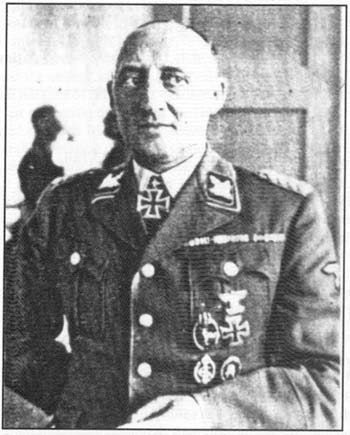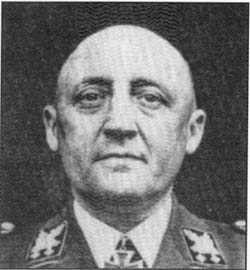On 12th April, Huta covered themselves vis à vis the Bauleitung by telling them that since the floors of the Krematorium III ["II” in the text] basements had only a single layer of damp proofing, Vedag refused to give the usual guarantee of two years and that under these conditions Huta were unable to do so.
On 13th and 14th April. Messing worked on the air extraction system of Leichenkeller 2 of Krematorium Ill, calling it in his timesheets “Auskleidekeller / Undressing cellar”.
On 16th April, Topf & Sons wrote to the Bauleitung concerning the damaged blowers of the forced draught installation of Krematorium II [designated “I” in the letter, even though the subject of this letter is without doubt Kr II and III], requesting them to be returned to Erfurt immediately on removal. Topf credited the Bauleitung with the sum of 3.705 RM, but refused to return the metal ration coupon arguing that they could no longer use it for other orders.
Having received an order from the Bauleitung on 16th April for the fittings for ONE “Gastür / Gas [tight[ door” (which was ready on 20th), the Auschwitz DAW metalworking shop that same day requested the iron required for FIVE such doors [for worksites 30a and 30b, Krematorien III and IV]. The metalworking shop was killing two birds with one stone, for the fittings to be produced were for the “Gastür” of Krematorium III and for the four doors of the two [at this date!] gas chambers of Krematorium IV.
From 17th to 24th April, a gang from Messrs Josef Kluge of Gleiwitz covered the dissecting table of Krematorium III with granite ["Terrazzo"] and took it to the Krematorium, where it was installed.
From 19th to 22nd April, Messing continued work on the air extraction system of Leichenkeller 2 of Krematorium III, still calling it the “Auskleidekeller / Undressing cellar”.
Worksite 30a was deserted on 1st and 2nd May, despite the fact that it was way behind schedule (it should have been finished on 10th April] because of the Labour Day holiday. Nobody was gassed on these two days.
On 4th May, Janisch replied for the Bauleitung to the Huta letter of 12th April [Document 56]. The scapegoat was naturally somebody who was absent, damp proofing foreman Krause of Vedag, meanwhile called up in the Wehrmacht, who had authorized the single layer of proofing material. His replacement refused it, saying that two layers were necessary for Vedag to be able to give their two-year guarantee. The Bauleitung, probably tired of these futile arguments which were holding up work on Krematorium III, was conciliatory on this matter, agreeing that work should continue with two layers provided a damp proofing guarantee was given, and waiving the guarantee with respect to the work already done with only a single layer.
In the afternoon of the same day, SS Major Alfred FRANKE-GRICKSCH, adjutant to SS General Maximillian VON HERFF [Documents 57 and 57a], Head of the SS Central Personnel Office [SS Personal Hauptamt, 98 99 Wilmersdorferstraße, Berlin-Charlottenburg], accompanying the General on a tour of inspection in the “General Government” [the half of the Polish territory occupied by the Germans and placed under the authority of Hans Frank], arrived in KL Auschwitz (although reported, the presence of General von Herff is doubtful). Franke- Gricksch visited Krematorium II and is supposed to have witnessed the gassing of those unfit for work from a convoy of 2,930 Greek Jews (from the Salonika ghetto). Following this visit, between the evening of 4th May and 16th May, he wrote a report on what he had seen at Auschwitz Birkenau for his chief, von Herff, and for Reichsführer SS Himmler. This report was entitled: “JEWISH RESETTLEMENT ACTION” [Document 58]. |
|
| Document 57 |
Document 57a |
 |
 |
|
| Documents 57 and 57a (Personal archives) |
Maximillian von Herff, Alfred Franke-Grisch’s chief. Born in Hannover on 17th April 1893, died in September 1945 in a prison camp in England.
Left: As SS Brigadier-General, probably in August 1942, when he was made Head of the SS Central Personnel Office, a position he held until May 1945.
Right: Wearing the uniform of the highest rank he held: SS Lieutenant-General |
|
On 5th May, the Auschwitz DAW metalworking shop received an order from the Bauleitung, made out the previous day for the production of “2 handrails [for stairways ], each 7.70 in long, 1 m high (see sketches 1 and 2)” and “2 handrails, each 12.20 m long, 1 m high each (see sketch 3)” “for the 2nd basement stairways” [die 2- ten Kellertreppen]. This order requesting delivery for 14th May, was not completed until 25th. [As the original orders of the “WL metalworking shop / Schlosserei WL” are not in the possession of the PMO, the three sketches are not known.] A study of Bauleitung drawings 2003 and 2197 reveals that the two 7.70m guardrails, at different form, were for the access stairways to the basement vestibules of Krematorien II and III (running from the north yard of Kr II and the south yard at Kr III) [Figures 1 and 2] . The two others of 12.20 m, identical in form, were for the access stairways to the undressing rooms (Leichenkeller 2) of Krematorien II and III [Figure 3]. They were removed when Krematorien II and III were dismantled in December 1944 and found intact in the “Bauhof” after the Liberation of the camp [Document 59].
On 11th May, Jährling wrote an urgent telegram to Messrs Topf of Erfurt, signed by Kirschneck and sent by the civilian employee Ludwig at 18.01 hours, requesting that Prüfer set out for Auschwitz without delay and that the drawings and calculations for the chimneys and the installation instructions for the temporary Demag III goods hoist [for Krematorium III] be sent at once. This telegram does not state which building(s) the chimneys were for. |
[This urgent telegram was the first of a series, the total number of which is not known, reflecting the general air of panic reigning in the Bauleitung. The crematorium situation in Birkenau had suddenly deteriorated as the remaining telegrams in the series show: Krematorien IV and II, handed over on 22nd and 31st March respectively, WERE OUT OF ORDER. with damaged chimneys; Kr III, although not completed, could have been operational IF it had been possible to feed the furnaces with corpses from the basement, but this was not the case, as the goods hoist could not be installed because the instructions were not available! (Messing started installing in on 17th May and completed the job on 9th June), Only Krematorium V was functioning correctly.]
|
Hearing nothing from Topf, Jährling sent a second urgent telegram on 14th May, this time signed by Bischoff, requesting the static and thermal calculations for the chimneys of Krematorien II and IV and insisting that Prüfer should come to Auschwitz [Document 60]. The civilian employee Schwender sent the text at 1600 hours. This telegram in fact confirmed a telephone conversation between Jährling and Topf in the morning, in which he had learned that Prüfer was on a business trip in the Rhineland. but would do his best to arrive in Auschwitz by Monday 17th May. Only ONE AND A HALF HOURS LATER. Schwender sent another urgent telegram to Topf, signed by Bischoff and, in view of the late hour, dated and filed the next day [Document 61]. In this telegram, Jährling requested the urgent study of an installation to obtain hot water from the waste incinerator of Krematorium III, then under construction, to supply about one hundred showers (probably to be located in an annex building built on the southern wall of the Krematorium). Prüfer was supposed to bring the relevant drawings with him on 17th May. [This plan was never implemented, although such installations were built in other camps, for example in the crematorium of K L Natzweiler (Struthof) where the incinerator was the main source of heat for the showers]. Although this request for a hot water system for a hundred NORMAL showers was in no way criminal it was recorded in the Krematorium III, worksite 30a, file under the heading “SONDERMASSN[AHMEN] / SPECIAL MEASURES” because the funding was connected with these measures, the killing and cremation of Jews unfit for work.
On Monday 17th May, it is more than likely that Prüfer arrived at Auschwitz as arranged. As we have no formal proof we cannot be categorical, but if Messing began installing the lift of Krematorium III precisely on 17th May, this was not simply a whim on his part, but because he had received the installation instructions brought by Prüfer. The engineer was certainly present on 18th [Topf letter of 9/6/43]. According to subsequent telegrams it is clear he had not brought the drawings and calculations required for the repair of the chimneys of Krematorien II and IV, and in fact he could not reasonably produce them until he had seen the location and extent of the damage. It was only after inspecting Krematorien II and IV that the following decisions could be taken, after consultation with Bischoff: repair Kr II as quickly as possible, abandon the operation of the Kr IV furnace completely and improve the operation of Kr V by fitting its gas chambers (and those of Kr IV, still intact) with an air extraction system. |
[This abandonment of Krematorium IV was not formally stated (and for good reason! This is particularly evident on reading the letter of 28th June 1943 on the throughput of the Krematorien), but it can be deduced from several pieces of evidence: subsequent correspondence between the Bauleitung and Topf makes no mention of its repair; Camp Commandant Hoess in his memoirs states that “Number III [Kr IV] failed completely after a short time and later ceased to be used altogether"; after the first fifty days (22nd March to 10th May 1943), during which time operations had to be interrupted at least once for repairs to fissures that had appeared in the furnace, and during which time less than 10,000 victims were cremated (probably 6,000), not a single member of the Sonderkommando reports having worked on the furnace of Krematorium IV. What is more, Krematorium V being of identical design, it was to be feared that it would suffer the same damage unless it was used more moderately. Despite the fact that Kr V had to be “handled with care”, it absolutely had to go on being used until Krematorium III came into service. It was then mothballed, barely operational. In 1944, despite repairs the furnace of Krematorium V was as inefficient as ever and operations were frequently interrupted by breakdowns, so open air cremation ditches were dug near the gas chambers. It would appear that Krematorium V really worked for only two months in 1943, annihilating about 15,000 victims. In summer, 1944, it can be"credited” with about 50,000 people gassed, but they were cremated in the open-air ditches.]
|
|

